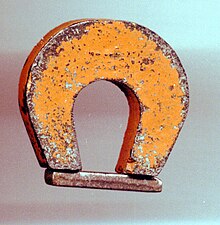Alnico
Alnico is an alloy made up of iron with aluminium (Al), nickel (Ni) and cobalt (Co).[1] The name "Alnico" is an acronym from Al-Ni-Co. Alnico may also contain copper and sometimes titanium.

Alnico alloys are ferromagnetic (a mechanism by which some materials form permanent magnets). Alnico alloys also have a high coercivity (they do not easily lose their magnetism) and are used to make permanent magnets. Before rare-earth magnets were developed in the 1970s, lnico magnets were the strongest type of magnet. The development of Alnico began in 1931 when T. Mishima in Japan found that an alloy of iron, nickel, and aluminium had double the coercivity of the best magnets of that time. (the coercivity of Alnico is 400 oersted).[2]
Properties
changeAlnico alloys can be made magnets by strong magnetic fields. Rare-earth magnets like neodymium and samarium-cobalt are the only easily found magnets which are stronger than alnico magnets. Alnico magnets produce very strong magnetic fields at their poles (a pole is one of the two ends of a magnet) as high as 1500 gauss (0.15 tesla which is about 3000 times stronger than earth's magnetic field.
Some types of alnico magnets are isotropic (properties are same in all directions) and can be properly magnetised in all directions. Other types like alnico 5 and alnico 8 are anisotropic (properties change when direction changes) have a preferred direction (one direction would be better than other directions) for magnetisation. Anisotropic alnico alloys will make stronger magnets in their preferred direction than an isotropic alnico alloy.
Alnico magnets are the only magnets that have useful magnetism even when heated red-hot.[3] [4]
In 2008, the cost of Alnico magnets was about $44/kg ($20/pound).[5]
References
change- ↑ Hellweg, Paul 1986 (1986). The Insomniac's Dictionary. Facts On File. pp. 115. ISBN 0-8160-1364-0.
{{cite book}}: CS1 maint: numeric names: authors list (link) - ↑ Cullity B.D. & Graham C.D. 2008 (30 March 2009). Introduction to Magnetic Materials. Wiley-IEEE. p. 485. ISBN 978-0471477419.
{{cite book}}: CS1 maint: numeric names: authors list (link) - ↑ "Arnold-Alnico Magnets". Archived from the original on 2007-10-28. Retrieved 2011-06-01.
- ↑ Hubert, Alex & Schäffer, Rudolf 1998 (1998). Magnetic domains: the analysis of magnetic microstructures. Springer. p. 557. ISBN 3540641084.
{{cite book}}: CS1 maint: multiple names: authors list (link) CS1 maint: numeric names: authors list (link) - ↑ "Frequently Asked Questions". Archived from the original on 2019-03-12. Retrieved 2011-06-01.